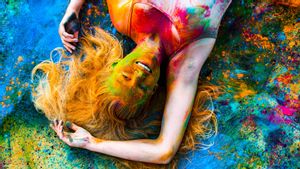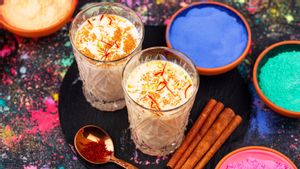One of the most vibrant Indian festivals, Holi is synonymous with all things colour. Also called Holaka, Phagwa, Dhulheti, Dhulandi or Dhulendi, this festival is primarily a springtime festival and a celebration of the arrival of the harvest season. However, the triumph of good over evil is a tried and tested theme resurfacing in early scriptures Narad Purana and Vishnu Purana thereby giving this festival a religious touch.
Holi is celebrated across the country on the last full moon day of the Hindu lunisolar calendar month, which is usually March. This year, Holi, the festival of colours, is scheduled to fall on March 17 and 19 respectively.
Explained, the tradition of burning a bonfire before Holi
Other than its importance as a spring festival, there are various myths surrounding the origins of this festival. One such belief is that the festival derives its name from the demon princess Holika, sister of the megalomaniac King Hiranyakashayapu.
The legend goes that Lord Vishnu assassinated the demon lord’s younger brother, Hiranyakashipu. Apart from avenging his brother’s death, the demon king had the ulterior motive of ruling heaven, earth, and the underworld by defeating Lord Vishnu, the preserver and protector.
Powered by a boon granted to him, Hiranyakashipu thought he had become invincible, and that he was the only ruler of the universe. However, his own son Prahalad, a follower of Lord Vishnu, thought so otherwise. Angered, Hiranyakashipu devised a plan to kill his own son with the help of his sister Holika, who was believed to be immune to fire.
Sticking to the plan, a pyre was lit and Holika sat in it holding on to Prahalad. As luck had it, Prahalad managed to make it through the fire unscathed, while Holika burned to ashes. Eventually, Hiranyakashipu too was killed by Lord Vishnu, who is said to have taken the avatar of Narasimha (half-man and half-lion).
Holika’s cremation is reenacted by the burning of bonfires on the night before Holi and is known as Holika Dahan or Choti Holi.
Another belief surrounding the festival’s celebration is associated with the legend of Lord Shiva. As the story goes, Madana, the goddess of love, tries to tempt Shiva who at that time was meditating. Despite taking the form of a beautiful nymph, Shiva was able to recognise Madana, making him lose his calm. In a fit of rage, he shot fire out of his third eye, the eye of destruction, reducing her to ashes – another reason behind the burning of the bonfire during the Holi celebration India.
The tradition behind throwing colour
Rangwali Holi (festival of colours) or Badi Holi is an all-day affair where people throw and smear coloured powder on each other. The tradition of throwing coloured powder and water is believed to originate from the mythological love story of Radha and Krishna.
Krishna, the Hindu god depicted with dark blue skin, is believed to have complained to his mother Yashoda about Radha's fair complexion. To pacify young Krishna, his mother suggested he paint Radha's face in any colour he wanted. Upon his mother’s advice, the natkhat Krishna coloured Radha’s face blue – this is where the custom of smearing loved ones with colour during Holi found its roots.
HOLI FESTIVAL IN INDIA
While each region has its own unique take on the festival, bright coloured powders are the mainstay – painting the whole country in mesmerising hues of blues, yellows, greens, reds, and more. Read on to find out how different parts of the country partake in this festival of colours.
West Bengal, Assam and Tripura

In these parts of the country, the festival of colours is celebrated as Basant Utsav and also Dol Jatra. Basant here translates to spring, thereby marking the beginning of the new season.
While Holi is based on the legend of Prahlad, Dol revolves around Krishna and Radha. Not to be confused, both Krishna and Prahlad are incarnations of the same Hindu god, Lord Vishnu. Celebrated a day before Holi, Dol begins the day after a full-moon night in the Bengali month of Phalgun and is the last festival on the Bengali calendar.
Legend has it that while Radha and the other gopiyas were playing around a swing, natkhat Krishna sneakily colours her face with ‘Phag’ or powdered colours. The first confession of Lord Krishna’s love for Radha, this moment was then celebrated by carrying the two on a colourful palanquin around the city. That’s how Dol Jatra came about – ‘Dol’ meaning swing and ‘Yatra’ meaning journey.
Replicating the same, even today Dol Jatra is celebrated the same way - a procession of an idol of Lord Krishna is taken out and the streets get transformed into a riot of music, colour and dance.
In West Bengal, the tradition of Basant Utsav was started by Rabindranath Tagore, the legendary Bengali poet, musician and artist, at the Visva Bharati University in Santiniketan. Therefore, Dol in these parts does not celebrate religion alone, but also nature. The women here dress in bright yellow coloured sarees, signifying the abundance of nature.
In addition to the play of colours, the atmosphere is also filled with Tagore’s poetry recitals, songs and traditional dance programmes. Apart from the grand affair at Shantiniketan, the Purulia district of West Bengal, too, celebrates a three-day Basanta Utsav folk festival which is dominated by traditional folk dances such as the Chau dance, Darbari Jhumur, Natua dance, and songs of Baul musicians.
Uttar Pradesh
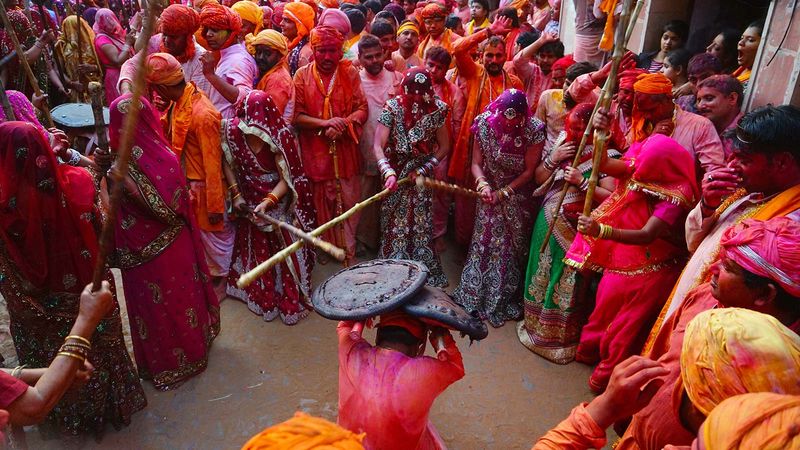
Most regions traditionally celebrate this festival with their own local revelries, many of which relate to specific episodes of Krishna and his beloved consort Radha. One of the most popular of those revelries is the Lathmar Holi in Uttar Pradesh. It’s traditionally held one week before Holi.
During Lathmar, men from the Nandgaon village, the traditional hometown of Krishna, impersonate the prank-loving deity and defend themselves with shields while colourfully dressed women from the nearby Barsana, Radha’s hometown, pummel the men with long wooden sticks or lathis.
The tradition dates back to Dwapar Yug, when Lord Krishna came to meet his beloved Radha and mischievously teased her and her sakhis. To take revenge, the women of the village chased him away with their lathis.
This festival is celebrated over 16 days and comes to an end on Rangpanchami (festival of colours). A couple of days before Lathmar, Barsana celebrates Laddoo Holi wherein sweets are thrown around and spiritual songs related to Radha and Krishna are sung.
Vrindavan, on the other hand, is believed to be the place where Radha and Krishna met for their secret rendezvous in the garden of Krishna Leela, too celebrates the festival of colours on a grand scale. The week-long celebrations include parades, performances of ‘Raas-Leela’ and even cultural shows.
Worth a mention are the celebrations at Banke Bihari temple which start off with the throwing of flowers, known as Phoolon wali Holi, held a few days prior to Holi festival in India. While in many parts of the country widows are not permitted to play Holi, it was only until 2012 that the widows of Vrindavan have been celebrating the festival of colours at the historic Gopinath temple.
The city of Varanasi, on the other hand, celebrates Holi by smearing "Chita Bhasma" or funeral pyre ashes instead of coloured powdered. The tradition of smearing ashes is carried out as an act of purification and is believed to have been started when Lord Shiva smeared ashes all over himself to marry Parvati. But beyond the famous Lathmar Holi and Phoolon ki Holi, the festival is celebrated in unique styles across the country. Scroll on.
Odisha

In the coastal districts of Odisha, Holi is known as Dola Purnima and is celebrated in a similar fashion as it is in its neighbouring state of Bengal. The only difference being that instead of a procession of the idols of Krishna and Radha on the swing, it’s the idol of Lord Jagannath.
Celebrated over a period of five days, beginning from the tenth day of the fortnight of Phalgun also known as Fagu Dasami, the first four days sees the palanquin, or veemana, with the idol of Lord Jagannath being taken around. All this while women dance and sing devotional songs, and the men paint the state with coloured powder called abeer.
On the fifth day, all the deities are assembled at one commonplace and then the swings are placed. This tradition finds a reference in certain scriptures where the festival is called "Dolatsaba", meaning swing festival. Holipoda, the burning of the hut made of straw is another important Holi tradition in this part. In some villages, it is also known as Mendhapod. Some places in Odisha also organise fairs called melana which continues till the month of Chaitra.
Manipur
In this north-eastern state, the festivities last six days, starting on the full moon day of Phalguna and then blending into the ancient Yaosang festival. The most important festival of the state, Holi here celebrates the local customs and traditions of the Meitei community and is deeply influenced by Vaishnavism. It was only during the 18th century when King Meidingu Pamheiba declared Hinduism as the state religion and converted a majority of the Meitei community that Yaosang came about as a Hindu festival. Before that, it was only a harvest festival.
At heart, the very name, Yaosang, hints at the festival’s agrarian origins – ‘Yao’, meaning sheep and ‘Sang’, meaning shed. With the advent of Vaishnavism, this state, too, has a tradition of burning a thatched hut made with hay, twigs and sticks. Worth a mention is Thabal Chongda, a Manipuri folk dance that is performed on each of the six days. Sports, too, take centre stage during this time – Manipur is also known as India’s sport’s capital. On the first day of the festival, people head to the Kangla Fort at Imphal for the lighting of the torch upon which the sports meet is officially inaugurated.
Haryana
In this northern state, Holi assumes a new form, Dulandi Holi, also known as Dhulendi and Vasantostav. What’s a unique take on the festival is the tradition of sisters-in-law beating their brothers-in-law or devars in mock anger. In the evening the devars are expected to show up with sweets for their sisters-in-law to earn their goodwill.
Punjab

Holi festival in India's Punjab is celebrated as Hola Mohalla, an annual fair held at Anandpur Sahib, a city in the state. Dating back to the 17th century, this fair is believed to have been organized by Sikh Guru Gobind Singh to celebrate Holi. It’s only in this part of the country where instead of throwing colours, the festivities take an unexpected turn - wrestling, martial arts, mock sword fights, acrobatic military exercises, and turban tying.
Himachal Pradesh
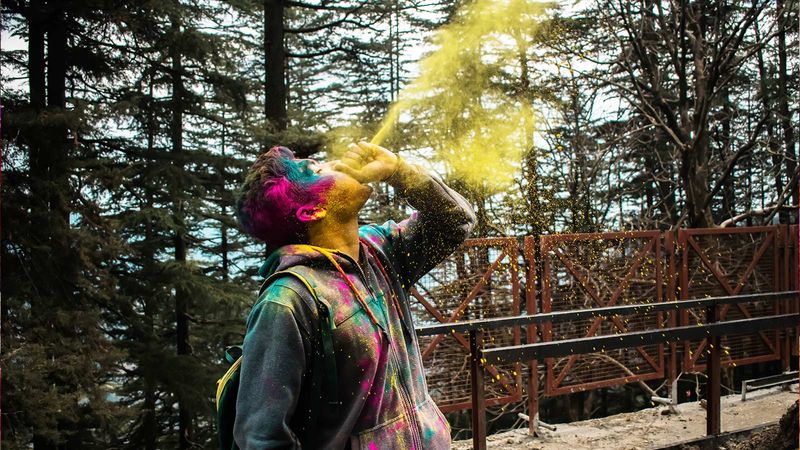
While Holika Dahan, the burning of the bonfires marks the beginning of the festivities in the rest of the country, Holi here comes to an end with this ritual. Celebrated over a period of 40 days, Holi here comes early. Starting on Basant Panchami, the history of making Holi more than a month-long affair dates to the 16th century.
The then ruler of Kullu, Jagat Singh brought the idol of Lord Raghunath from Ayodhya in Uttar Pradesh and installed it at Sultanpur in Kullu, which was then followed by the building of a temple named after the deity.
Since then, every year, people gather at the temple to apply gulal to Lord Raghunath, the presiding deity of Kullu. This part of the country, too, witnesses the ceremonial burning, locally called ‘Faag’ near the Raghunath temple. A unique take on the festival of colours here is the mixing of colours with snow – also called Ice Holi.
Uttarakhand
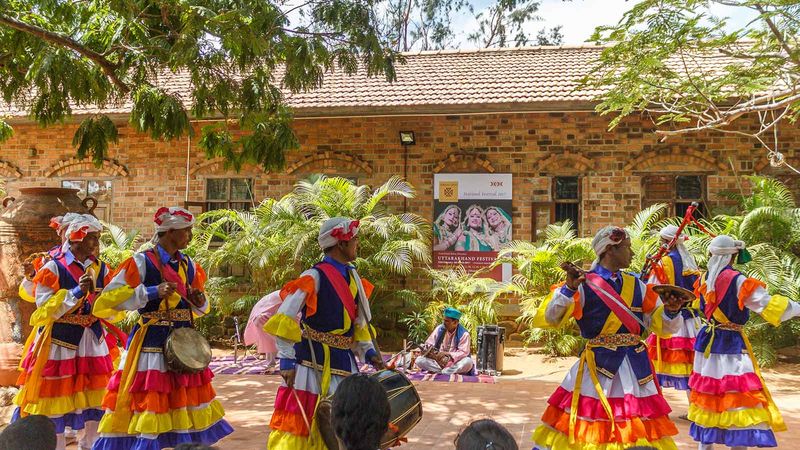
Here Holi is more of a musical gathering where locals don their traditional attire, sing traditional regional songs and go around the city in groups called Tolis. The festivities in Kumaon village take place in three different forms - Baithaki Holi, Khadi Holi and Mahila Holi.
While Baithaki is celebrated by musical performances based on the life of Lord Krishna, Khadi sees men sporting traditional attires and dancing and singing to the tunes of the dhol and hurka (traditional musical instruments), and Mahila, which is exclusively organised for women, is quite like Baithaki.
Rajasthan

Celebrations here unfold in various forms, each one unique and distinct from the other. The 'mali' or gardener community of Rajasthan celebrate Holi in a similar fashion as the people of Mathura. While men smear coloured powder and water over the women, the women retaliate by hitting them with sticks or long pieces of cloth.
The city of Udaipur, on the other hand, celebrates what is known as Royal Holi. As the name suggests, the celebrations are kickstarted by Mewar’s royal family. The ritual of the burning of the bonfire, usually limited to the custodian of the Mewar dynasty, is followed by a colourful and fancy procession of horses and royal bands.
In the Braj region of Bharatpur district of Rajasthan, Holi is celebrated as Braj Mahotsav for over three days. The town of Bikaner celebrates Dolchi Holi which is limited to only the menfolk of the Harsh and Vyas communities in Rajasthan. Interestingly, Holi here is not celebrated with colours, but instead with water. Water is splashed over others using small vessels made from camel skin, known as Dolchi, and thus the name of the festival.
Jaipur celebrates the Dhulandi Festival, a day after Holika Dahan by playing with colour, which is then followed by traditional folk songs and performances.
Tamil Nadu, Telangana, Karnataka and Andhra Pradesh
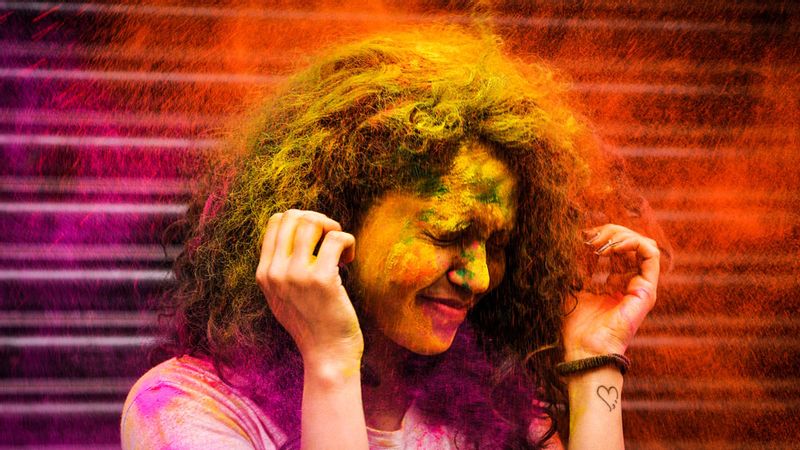
Down south, the legend of Holika isn’t that popular, however, these states do celebrate the day as Kamadahanam, which refers to the burning of Kamadeva, the goddess of love by Lord Shiva. Also known as Kamavilas and Kaman Pandigai, Holi here is celebrated as a festival of love, marking the victory of spiritual bliss over material desires.
According to legend, after Shiva loses his wife Sati, he turns into an ascetic giving up on worldly pleasures. With Tarakasura, the demon god, rising to power, the other gods realized that their only hope was Lord Shiva. They then devise a plan with Kamadeva to help Shiva break his vow of celibacy. Sticking to the plan, Kamadeva tries to seduce Shiva, however, Shiva soon realises that he is being tricked and turns Kamadeva into ashes.
It was only after Parvati, an incarnation of his former wife Sati, explains to him all of what happened that he understands the situation. To make amends, Shiva revives Kamadeva in a formless manner, who then came to be known as ‘Ananga Dev’ or the one without a body. In due course of time, Lord Shiva reunited with goddess Parvati and bear son Kartikeya who goes on to destroy Tarakasura, ending his reign of terror and chaos. These states practice Kamadahanam, a ritual similar to Holika Dahan wherein sticks, cow dung and dried grass are burnt, and then the sacred ash is distributed amongst all.
Goa
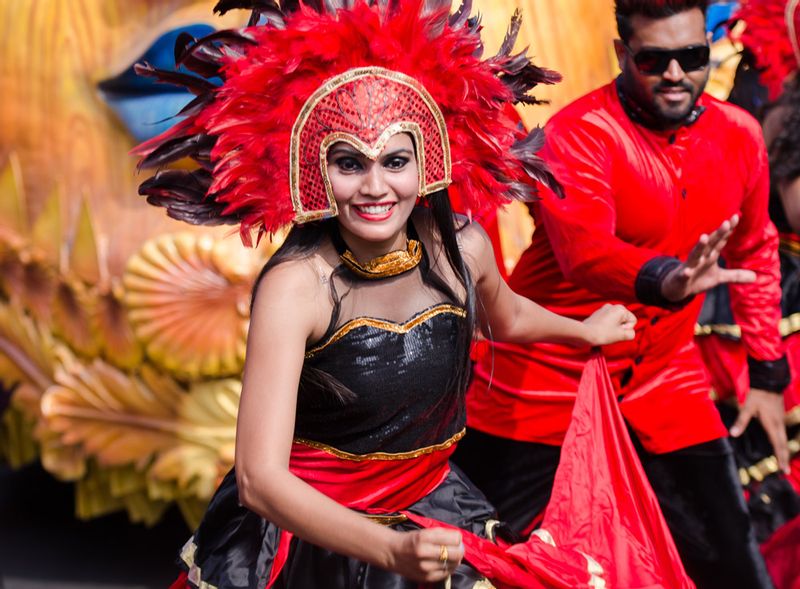
This state has its own brand of Holi, called Shigmo, which is similar to the festival of colours. A celebration of culture where the majority of the Hindu and Konkani population partake in, Sigmo or Shigmo is organised by the Panaji Shigmotsav Samiti.
An important part of the celebrations is the Shigmo parade, which starts in the capital city of Ponda, moving on to other cities such as Panjim, Mapusa and Bicholim among others. Stretched over a fortnight, on the last five days of the celebrations, expect drum performances, plays and cultural events supported by processions of enormous effigies of demons like Nakasur.
While Dhakto Shigmo is celebrated by the rural population, Vhadlo Shigmo is celebrated by the rest.
HOLI AROUND THE WORLD
While Holi is best enjoyed in India, it is celebrated with equal gusto and fervour by people around the world acting as a great equaliser. This year, however, many of these events will not take place.
Nepal
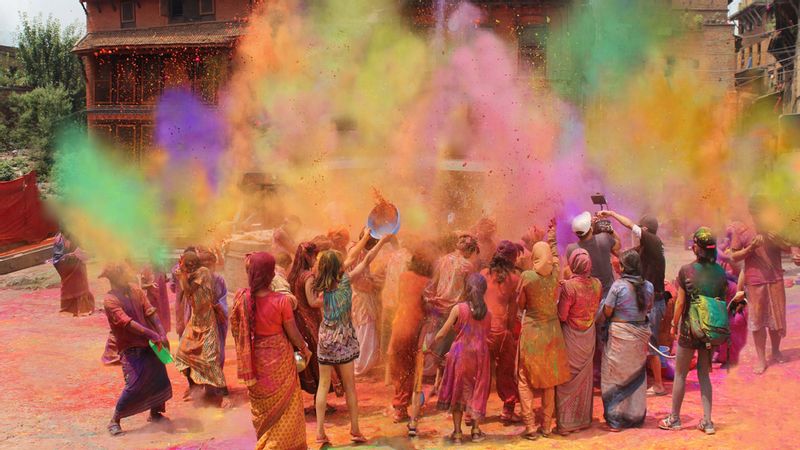
Celebrated over a week, Holi here too is a spring festival and marks the triumph of good over evil. On the first day of the festivities, a bamboo pole called chir is installed on the streets of Basantapur, the heart of Kathmandu city in Nepal, with strips of cloth attached to it. These strips of cloth are believed to be good luck charms that are then set ablaze during the traditional bonfire. The festival ends with playing with colours.
Germany
While the chaotic spectrum of colour that is Holi is celebrated with much pomp in Frankfurt, Hamburg and Munich, the city of Berlin is considered to be the main affair. Here, the events are delayed until summer on account of the weather and usually take place sometime between July till August. Not to miss is the ‘Holi Festival of Colours Berlin’, an electronic music festival held annually. This modern approach brings together world-renowned DJs, thereby attracting large crowds to celebrate this festival dancing away.
North America
Canada, dominated by a large Indian population, celebrates Holi the traditional way by starting off with Holika Dahan and then moving on to Rangwali Holi, which is played with talcum powder and coloured powder.
The festival of colours is even celebrated in the Canadian Parliament in Ottawa. Started back in 2016 as part of an initiative by Chandra Arya, an MP from Nepean and the Indian High Commission, the celebrations here involve a number of musical and dance performances which are then followed by the throwing of gulaal. Besides, Canadian Prime Minister Justin Trudeau, every year releases an official statement wishing all the Hindu communities a happy Holi around this time.
Australia
Large-scale Holi celebrations only came to Australia recently but have already spread to cities all over the country, with Melbourne hosting multiple large-scale events. While the ‘Rang Barse – Festival of Colours’ event is a display of India’s culture in the form of musical and dance performances, ‘Colorfest Melbourne’, on the other hand, gives the festivities a modern twist by making it all about dancing and partying.
Mauritius
Since the majority of the population here follows Hinduism, the festival of colours is a long-standing tradition on the island that kick-starts with a bonfire on the beach, followed by folk songs and dancing. Celebrations reach their height at the capital, Port Louis, where people gather to play with brightly-coloured powders or gulaal and water pistols made of bamboo stalks.
United Kingdom
Neasden Temple, the biggest Hindu temple in northwest London, hosts one of the country’s largest Holi celebrations called The Holi Festival. A large bonfire is lit where the newly harvested grains are then offered to the fire deity, which is then followed by adorning of the murtis in vibrant colours.
Photo: Shutterstock



